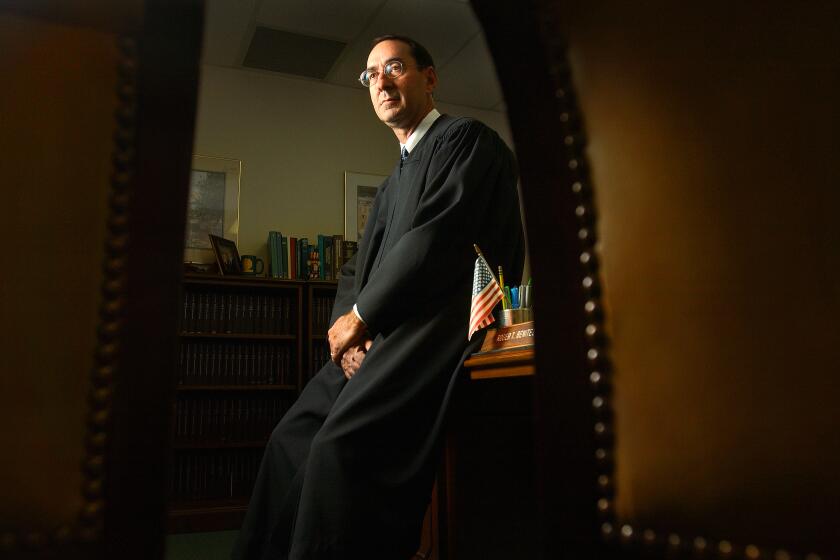A Timeless Lesson on Immigrants’ Hopes, Hardships : Education: During overnight stint as tall ship’s ‘crew,’ students get a taste of what 19th-century voyagers endured in quest for better lives.
The commands are crisp and are barked out in a knife-sharp voice that is demanding, impatient and not a little menacing.
“Hurry up! Get your hands out of your pockets.”
“Get that thing off your head.”
“Get those toes touching the heels in front of you.”
“When you hear the word ‘avast,’ you will freeze. The only things that should be moving are your heart, your lungs and your eardrums.”
The order-barker is Philip Clinton of the Orange County Marine Institute. He’s playing the tough-guy role of first mate on an 1874 merchant ship--The Star of India--outward bound from England with a cargo of penniless, unseaworthy and potentially scurvy-ridden immigrants.
The immigrants are 26 sixth-grade students from the suburban Encinitas school district who have been studying immigration--past and present--and are now spending the night aboard the Star of India, the oldest active tall ship in the world. It’s a natural fit.
From 1871 to 1898, the Star of India, then called the Euterpe (for the Greek goddess of music), made 21 of the perilous, five-month trips from England around Cape Horn (the “killer of great ships”) to deliver immigrants to New Zealand and Australia. Each trip packed upward of 400 immigrants.
Now the 278-foot-long ship is again involved in the immigrant trade, this time as the venue for an innovative educational effort to teach students about the hardships and hopes of immigrants forced by economic and social circumstances to flee their homelands in search of a better life.
For decades the three-masted Star has been docked at the Embarcadero here and lovingly maintained as an attraction of the San Diego Maritime Museum. Only occasionally is it taken out for a short sail to prove the stoutness of its iron hull and its guardians.
But there was a time when the proud ship with the tall sails represented the path to a better life for thousands of desperate European immigrants, including those without a penny to their name.
The Star of India program, now in its first month, is a joint venture of the San Diego Maritime Museum and the Orange County Marine Institute. The institute provides experienced role-players who have honed their skills as part of a similar program aboard the Pilgrim at Dana Point.
Immigration, of course, is not just a page from the history books, it’s also the stuff of front-page news. No mention is made of the current red-hot debate, but if the students want to sense a similarity between the travails of immigrants fleeing on a ship in 1879 and immigrants fleeing over a wire fence in 1995, so much the better, say the course leaders.
“If there is one thing we want to teach them it’s empathy: empathy for people who leave their homes and what they endure,” said Karin Wyman, who played the blood-and-guts captain on this “voyage.”
The path to empathy begins with verisimilitude. The immigrants aboard the Euterpe left behind copious journals describing the harshness and the occasional joys.
Those who could afford to pay for their passage were given accommodations that were crowded but bearable. Those who couldn’t pay were allowed to work their way across as common sailors.
As the students from Kathie Jenuine’s class at Mission Estancia Elementary School learn soon after boarding the Star of India, there was nothing more expendable and vulnerable to contempt than an immigrant without money: a truth that is much the same today.
“They treated the immigrants very badly because they didn’t have money,” said Karen Benson, 11. “You have to have money to get respect.”
Wyman lectured the students/immigrants on the rules of the ship: Never disobey an order, never talk back, never look a paying passenger in the eye, never forget how expendable you are.
“We have plenty of men here,” Wyman said, “so even if we lose half of you at sea, we’ll still have enough to sail the ship.”
For 18 hours--from 3 p.m. Thursday until 9 a.m. Friday--the students are made to take orders, stow their gear, handle the ship’s lines, scrub the decks, wash the dishes, and later to stand two-hour watches and keep a log of every sight, sound and smell.
Dinner is “rat stew.” (An immigrant from 1879 wrote: “The rats were well cooked, the paste very nice.”) Sleep is fitful. Standing watch is cold and lonely (parents are nearby as “safety officers”).
There are references by the first mate to the quick application of a cat-o-nine-tails to the back of anyone not moving sharply enough. (In truth, no such instrument is ever seen.)
Anyone who drops a line or sits down when he should be standing or forgets what he should be doing is required to eat an onion, just like sailors of yore. Many onions are consumed before the “voyage” is over.
“The trick is to know how far you can push them,” said Michael Lahage, who plays the second mate. “You don’t want to push them to where the eyes get teary or the lip quivers. If they’re prepared, you can push them a little further because they know it’s role-playing.”
Part of the role-playing is a good cop/bad cop scenario.
“Stand up while doing your work,” intones Clinton, the first mate. “The captain don’t like to see little potato-pickers laying on his deck.”
The first mate is formidable and the captain (“I will make your life hell afloat”) even more so. But the second mate is an amiable jokester, and the cook sings sea shanties, plays a flute, professes to be the real King of England and soon develops a devoted following.
The students are hip to the role-playing, though.
“When they’re yelling at you, they’re really just yelling at your role,” said Jason Miller, 12.
“I’d rather take the Concorde,” said Mike Brabant, 11.
“They treated us pretty well for being lower than rats,” said Kristin Mathe, also 11.
At Dana Point, the Orange County institute’s overnight program for students, begun in 1980, is set around the 1834 voyage of the real Pilgrim, immortalized in Richard Henry Dana’s “Two Years Before The Mast.” Last year, the ship was booked 256 nights.
The institute has run a program in San Francisco aboard the C.A. Thayer since 1989. The theme is that it is 1906 and the Thayer is a lumber ship trying to find lumber to rebuild the city after the earthquake.
Daniel Sexton, director of maritime affairs for the marine institute, said that while the historical settings may differ, the overnight programs share common goals of imparting to the students a sense of seamanship and teamwork.
The Dana Point program has a lengthy waiting list. But any school class signing up today could be aboard the Star of India in just a few weeks after completing a unit of study. Cost is $60 per student.
The ship never leaves the dock, but the tide provides a surging motion that heightens the below-deck feel of being underway. As Mission Estancia’s voyage ended, students were asked to name the most memorable part. The session has been a rigor and the answers varied.
“Breakfast,” said Mike Lynn, 12.
More to Read
Start your day right
Sign up for Essential California for news, features and recommendations from the L.A. Times and beyond in your inbox six days a week.
You may occasionally receive promotional content from the Los Angeles Times.






